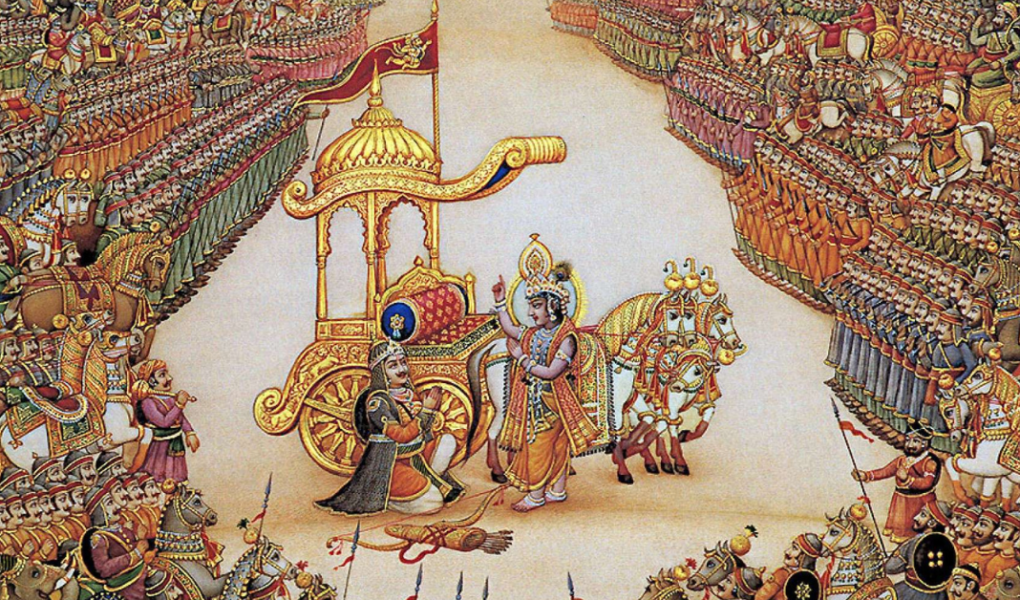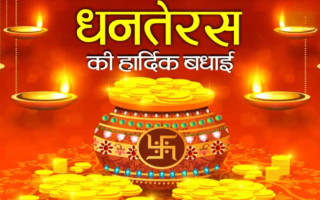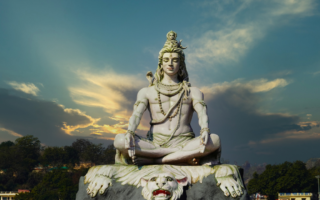Bhagavat Gita Quiz
Introduction

The Bhagavat Gita, sometimes referred to as “the Song of God,” is a sacred book brimming with timeless wisdom and a wealth of lessons. It is part of the epic poem of Mahabharata. In the Mahabharata epic, it is the sacred dialogue with the Lord Krishna and Arjuna that deals with the issues of living, duty and spirituality. It is a spiritual and moral guide. Bhagwat Gita isn’t simply an ode to religion; it’s a manual for living an enlightened and balanced life. It gives insight into the human struggle, moral dilemmas, and how to achieve self-realization. If you’re seeking to develop spiritually and gain mental clarity or aid in making choices, The Bhagwat Gita quiz will always be an excellent source of motivation.
Bhagavat Gita Quiz with Answers
Engaging fully with the fundamentals of the Bhagavat Gita and to dig into the deep meanings of its verses, Bhagavat Gita quiz can be an enjoyable experience. Quizzes aren’t just a way to test your knowledge, they can also help you comprehend the primary ideas of the scripture.
- What is the primary subject of the Bhagavad Gita?
a) Science
b) Philosophy
c) Warfare
d) Mathematics
Answer: b) Philosophy
2) In which Indian epic is the Bhagavad Gita found?
a) Ramayana
b) Mahabharata
c) Vedas
d) Upanishads
Answer: b) Mahabharata
3) Who is the narrator of the Bhagavad Gita?
a) Arjuna
b) Vyasa
c) Krishna
d) Sanjaya
Answer: c) Krishna
4) What is Arjuna‘s primary dilemma at the start of the Bhagavad Gita?
a) Fear of losing wealth
b) Confusion about his duty
c) Lack of weapons
d) Hatred for his enemies
Answer: b) Confusion about his duty
5) How many chapters does the Bhagavad Gita have?
a) 10
b) 15
c) 18
d) 20
Answer: c) 18
6) What is the literal meaning of the word ‘Gita’?
a) Song
b) Poem
c) Prayer
d) Knowledge
Answer: a) Song
7) What form of yoga does Krishna advocate as the highest path?
a) Karma Yoga
b) Bhakti Yoga
c) Jnana Yoga
d) Raja Yoga
Answer: b) Bhakti Yoga
8) What is Krishna’s primary advice to Arjuna?
a) Abandon the battle
b) Fight without attachment
c) Seek revenge
d) Meditate on the battlefield
Answer: b) Fight without attachment
9) What is the significance of the Kurukshetra battlefield?
a) A place of meditation
b) A symbol of internal struggle
c) A trade route
d) A royal court
Answer: b) A symbol of internal struggle
10) What does Krishna reveal to Arjuna in Chapter 11?
a) The secret of Karma
b) His universal form
c) The importance of devotion
d) The power of meditation
Answer: b) His universal form
11)What is the Sanskrit term for ‘duty’ in the Bhagavad Gita?
a) Dharma
b) Karma
c) Moksha
d) Artha
Answer: a) Dharma
12) According to the Gita, what binds a person to the cycle of birth and death?
a) Ignorance
b) Karma
c) Wealth
d) Knowledge
Answer: b) Karma
13) What is the ultimate goal of human life, as per the Bhagavad Gita?
a) Wealth accumulation
b) Liberation (Moksha)
c) Fame
d) Power
Answer: b) Liberation (Moksha)
14) Which sense organ does Krishna say is the most powerful?
a) Eyes
b) Mind
c) Ears
d) Tongue
Answer: b) Mind
15) What does Krishna suggest as the ultimate surrender?
a) Surrender to wealth
b) Surrender to God
c) Surrender to desires
d) Surrender to enemies
Answer: b) Surrender to God
16) What is the meaning of ‘Karma Yoga‘?
a) Path of devotion
b) Path of knowledge
c) Path of action
d) Path of meditation
Answer: c) Path of action
17) Which guna represents balance and harmony?
a) Sattva
b) Rajas
c) Tamas
d) Maya
Answer: a) Sattva
18) What is the term used for ‘knowledge’ in the Bhagavad Gita?
a) Vidya
b) Jyana
c) Upanishad
d) Samadhi
Answer: b) Jyana
19) What does Krishna compare the soul to?
a) A flame
b) A drop of water
c) A tree
d) A piece of cloth
Answer: a) A flame
20) How does Krishna describe the soul?
a) Perishable
b) Eternal and indestructible
c) Temporary
d) Born and reborn
Answer: b) Eternal and indestructible
21) Which chapter of the Gita explains the universal form of Krishna?
a) Chapter 10
b) Chapter 11
c) Chapter 13
d) Chapter 18
Answer: b) Chapter 11
22)What is the meaning of ‘Bhakti Yoga‘?
a) Path of action
b) Path of devotion
c) Path of meditation
d) Path of knowledge
Answer: b) Path of devotion
23) What is Krishna’s advice regarding the fruits of actions?
a) Seek them constantly
b) Detach from them
c) Avoid action altogether
d) Divide them equally
Answer: b) Detach from them
24) Which guna represents laziness and ignorance?
a) Sattva
b) Rajas
c) Tamas
d) Atma
Answer: c) Tamas
25) What is the Sanskrit term for liberation?
a) Moksha
b) Dharma
c) Karma
d) Bhakti
Answer: a) Moksha
26) What is the focus of Jnana Yoga?
a) Devotion to God
b) Meditation
c) Knowledge and wisdom
d) Physical strength
Answer: c) Knowledge and wisdom
27) Which type of action leads to liberation?
a) Action done with desire
b) Selfless and dutiful action
c) Action done out of fear
d) Action seeking power
Answer: b) Selfless and dutiful action
28) What is the root cause of sorrow, as per the Gita?
a) Ignorance
b) Wealth
c) Physical pain
d) Lack of resources
Answer: a) Ignorance
29) What is Krishna’s message about life and death?
a) Death is the end of existence
b) Life and death are part of a cycle
c) Life is permanent, death is an illusion
d) Fear death to attain salvation
Answer: b) Life and death are part of a cycle
30) What is the greatest yoga, according to Krishna?
a) Karma Yoga
b) Bhakti Yoga
c) Jnana Yoga
d) Raja Yoga
Answer: b) Bhakti Yoga

31) What does Krishna say about a wise person’s attitude?
a) They are indifferent to joy and sorrow
b) They seek material wealth
c) They avoid all challenges
d) They are ruled by emotions
Answer: a) They are indifferent to joy and sorrow
32) What does the word ‘Bhagavad’ mean?
a) God
b) Divine
c) Wealth
d) Spirit
Answer: b) Divine
33) Which guna represents passion and activity?
a) Sattva
b) Rajas
c) Tamas
d) Dharma
Answer: b) Rajas
34) What is the relationship between Krishna and Arjuna?
a) Teacher and Student
b) King and warrior
c) Father and Son
d) Enemies
Answer: a) Teacher and Student
35) What is the name of the battlefield where the Bhagavad Gita was spoken?
a) Mathura
b) Kurukshetra
c) Hastinapura
d) Ayodhya
Answer: b) Kurukshetra
36) Who is considered the supreme deity in the Bhagavad Gita?
a) Shiva
b) Krishna
c) Brahma
d) Vishnu
Answer: b) Krishna
37) Which chapter discusses the qualities of a yogi?
a) Chapter 5
b) Chapter 6
c) Chapter 8
d) Chapter 10
Answer: b) Chapter 6
38) What is Krishna’s cosmic form called in Sanskrit?
a) Vishwaroopa
b) Paramatma
c) Atman
d) Avatara
Answer: a) Vishwaroopa
39) What is the essence of Raja Yoga?
a) Control of the mind
b) Worship of God
c) Physical strength
d) Ritualistic sacrifices
Answer: a) Control of the mind
40) What is the primary duty of a Kshatriya, as described in the Gita?
a) Meditation
b) Fighting for righteousness
c) Wealth accumulation
d) Performing sacrifices
Answer: b) Fighting for righteousness
41) How does Krishna describe time in the Gita?
a) Eternal and unending
b) Temporary and fleeting
c) Controlled by humans
d) Dependent on seasons
Answer: a) Eternal and unending
42) What is the significance of the ‘middle path’ in the Gita?
a) Avoid extreme behaviors
b) Seek luxury and pleasure
c) Avoid meditation
d) Reject spirituality
Answer: a) Avoid extreme behaviors
43) Who listens to Krishna’s message along with Arjuna?
a) Drona
b) Sanjaya
c) Karna
d) Bhishma
Answer: b) Sanjaya
44) What does the Gita say about a person’s nature?
a) It is fixed and cannot change
b) It is determined by past actions
c) It evolves with discipline and wisdom
d) It depends on wealth
Answer: c) It evolves with discipline and wisdom
45) What is the meaning of “Atma”?
a) Soul
b) Mind
c) Wealth
d) Ego
Answer: a) Soul
46) What does Krishna advise about desires?
a) Fulfill them all
b) Renounce them completely
c) Balance them wisely
d) Control and transcend them
Answer: d) Control and transcend them
47) What is the Bhagavad Gita’s approach to happiness?
a) Seek material wealth for happiness
b) True happiness comes from detachment
c) Happiness depends on relationships
d) Avoid happiness as it leads to sorrow
Answer: b) True happiness comes from detachment
48) Who compiled the Bhagavad Gita into the Mahabharata?
a) Krishna
b) Vyasa
c) Arjuna
d) Sanjaya
Answer: b) Vyasa
49) What was the name of the conch blown by Lord Krishna in the Mahabharata?
a) Devadatta
b) Panchajanya
c) Anantavijaya
d) Sughosha
Answer: b) Panchajanya
50) In the Bhagavad Gita, Krishna describes three types of faith based on the three gunas. Which type of faith is related to Sattva?
a) Faith in material gains
b) Faith in divine principles
c) Faith in extreme austerities
d) Faith in demonic powers
Answer: b) Faith in divine principles
51) What does Krishna say about the nature of the three gunas (Sattva, Rajas, and Tamas)?
a) They are permanent and cannot be transcended
b) They are temporary and bind the soul to the material world
c) They are illusions and have no real impact
d) They are irrelevant to spiritual growth
Answer: b) They are temporary and bind the soul to the material world
52) How does the Bhagavad Gita define a ‘Stithaprajna’ (one of steady wisdom)?
a) A person who avoids challenges
b) A person free from desires and unaffected by pleasure or pain
c) A person who seeks material wealth
d) A person who follows rituals strictly
Answer: b) A person free from desires and unaffected by pleasure or pain
53) What is the significance of surrendering to Krishna, as per the Gita?
a) It guarantees material success
b) It frees one from all sins and grants liberation
c) It removes the need for action
d) It ensures victory in battle
Answer: b) It frees one from all sins and grants liberation
54) Which of the following describes the essence of “Svadharma” in the Bhagavad Gita?
a) Following societal norms blindly
b) Performing one’s prescribed duties in accordance with one’s nature
c) Abandoning all duties for personal freedom
d) Engaging in actions that lead to immediate results
Answer: b) Performing one’s prescribed duties in accordance with one’s nature
55) In the Bhagavad Gita, how does Krishna describe the material world?
a) As a permanent reality
b) As an illusion and a place of suffering
c) As a gift from the gods to enjoy
d) As irrelevant to spiritual progress
Answer: b) As an illusion and a place of suffering
56) What is the nature of action performed under the influence of Rajas, as per the Bhagavad Gita?
a) Action performed with detachment and wisdom
b) Action driven by selfish desires and attachments
c) Action performed in ignorance and laziness
d) Action performed for the benefit of others
Answer: b) Action driven by selfish desires and attachments
57) According to Krishna, what is the primary cause of bondage in the material world?
a) Karma performed without detachment
b) Lack of knowledge about scriptures
c) Worship of different deities
d) Failure to perform rituals
Answer: a) Karma performed without detachment
58) What is the significance of the “Tree of Samsara” mentioned in the Bhagavad Gita?
a) It represents eternal happiness and liberation
b) It symbolizes the root cause of attachment and the cycle of birth and death
c) It signifies material prosperity and success
d) It describes the physical world as the ultimate goal
Answer: b) It symbolizes the root cause of attachment and the cycle of birth and death
59) What was the name of the conch blown by Arjuna in the Mahabharata?
a) Devadatta
b) Panchajanya
c) Anantavijaya
d) Sughosha
Answer: a) Devadatta
60) What is Krishna’s divine chariot called?
a) Arjuna’s Chariot
b) Vishwajit
c) Kapi Dhwaja
d) Dharmaratha
Answer: d) Kapi Dhwaja
🌟 Transform Your Day with Timeless Wisdom! 🌟
Struggling with stress, distractions, or lack of clarity? Discover how the Bhagavad Gita’s eternal teachings can bring focus, mindfulness, and peace into your everyday life in short.
💡 Inside This PDF, You’ll Learn:
✅ Simple time management lessons from Krishna
✅ Mindfulness techniques rooted in ancient wisdom
✅ Stress-relief practices based on powerful Gita verses
📥 Download your short copy of “Bhagavad Gita for Daily Life” now and take your first step toward a calmer, more purposeful you.
🔗 [Click Here to Download]
Conclusion
The Bhagavat Gita transcends the borders between the past, present and future, offering guidance that is just as important as it was many years ago. Its guidelines encourage self-discovery as well as peace within, highlighting the necessity of righteousness and duty. Through studying the passages and utilizing instruments like Bhagavat Gita Quiz, which provides the answers you need to answer your queries, you’ll be able to increase your understanding and incorporate its timeless principles into your everyday life. Begin a spiritual journey and let to the Bhagavat Gita to assist you live an enjoyable and fulfilling life. Definitely the bhagavat gita quiz will help you to know about it.
Loved this post? Don’t stop here!
Dive into more exciting reads and discover tips, tricks, and insights on topics you care about.
Click below to explore our other blogs—you won’t want to miss them!
Why navratri celebrated for 9 Days
Navratri 2024 Colours Guide: Wear the Right Colour for Luck




[…] Bhagavat Gita Quiz […]